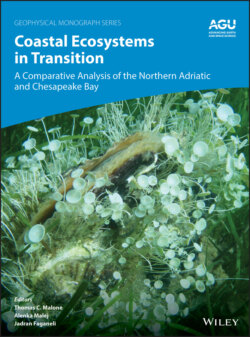Читать книгу Coastal Ecosystems in Transition - Группа авторов - Страница 34
2.4.3. Watershed Management
ОглавлениеFor CB, coordinated efforts have been implemented to reduce pollutant inputs since the first Chesapeake Bay Agreement was signed in 1983. Here we provide a brief overview of historical changes in management and practices associated with point, agricultural, and stormwater sources in the Susquehanna River (Zhang et al., 2013). For point sources, the more important historical controls were the P ban in detergents (Litke, 1999) and the adoption of increasingly effective nutrient removal technologies at wastewater treatment plants (Chesapeake Executive Council, 1988). For agriculture nonpoint sources, many strategies have focused on controlling fertilizer and manure applications, including regulations on storage and usage of animal manure and regulations on concentrated animal operations and feeding operations (New York State Department of Environmental Conservation, 2007; Pennsylvania Department of Environmental Protection, 2004; US Department of Agriculture and US Environmental Protection Agency, 1999). For stormwater sources, the USEPA initiated the National Pollutant Discharge Elimination System Phase I regulations in 1990 for Municipalities with Separate Storm Sewer Systems (MS4s) serving populations of 100,000 or more (US Environmental Protection Agency, 2000) and expanded the program in 1999 to include smaller MS4s (US Environmental Protection Agency, 2000). States also took actions to promulgate regulations on stormwater discharges in the late 1990s to early 2000s (New York State Department of Environmental Conservation, 2007; Pennsylvania Department of Environmental Protection, 2004).
For the NAS, efforts were made by Italian regulators to progressively reduce P content in detergents to 1% (6% for automatic laundry detergents) in 1989 (Marchetti et al., 1989; Rinaldi, 2014). In that year, industries also substituted sodium‐triphosphate‐based detergents with zeolite A (Glennie et al., 2002). The control of N loads has been improved recently with the adoption of the European Nitrates Directive (91/676/EEC). However, the reduction of N loads was less effective compared to that of P loads, because N is largely contributed by nonpoint sources (Viaroli et al., 2010, 2018). The creation of designated Authorities for specific hydrographic basins and of Regional Environmental Protection Agencies in 1994 further supported a coordinated monitoring of continental waters in Italy. The main measures adopted to reduce eutrophication from river loads were (a) establishment of spill basins and manure wastes for crop and livestock farming, (b) implementation of good farming practices in vulnerable areas, and (c) implementation of the Urban Waste Water Treatment Directive (91/271/EEC) (Bortone, 2014).
The N and P inputs in the NAS are not limited to riverine inputs. Direct inputs to the NAS occur via groundwater discharge and treatment plants, but are poorly quantified. Groundwater aquifers, particularly in the NE Adriatic region, are very sensitive to external pollution due to their large draining capacity of surface waters and low self‐cleaning potential (The EU.WATER Project, 2010). For treatment plants, several underwater pipelines have been built since the 1980s, especially in the NE Adriatic region. Despite a gradual upgrade of treatment plants from secondary to tertiary treatment, wastewater loads continue to be an important source of nutrients in the NAS (Cozzi et al., 2014; Scroccaro et al., 2010; Sekulić et al., 2004; Volf et al., 2018).
